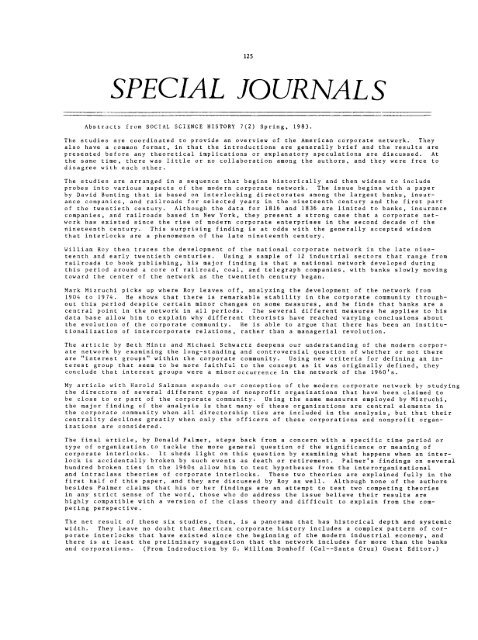(1985). Levine's Atlas of Corporate Interlocks. Connections ... - INSNA
(1985). Levine's Atlas of Corporate Interlocks. Connections ... - INSNA
(1985). Levine's Atlas of Corporate Interlocks. Connections ... - INSNA
You also want an ePaper? Increase the reach of your titles
YUMPU automatically turns print PDFs into web optimized ePapers that Google loves.
1 2 5<br />
SPECIAL JOURNALS<br />
Abstracts from SOCIAL SCIENCE HISTORY 7(2) Spring, 1983 .<br />
The studies are coordinated to provide an overview <strong>of</strong> the American corporate network . They<br />
also have a common format, in that the introductions are generally brief and the results are<br />
presented before any theoretical implications or explanatory speculations are discussed . At<br />
the same time, there was little or no collaboration among the authors, and they were free to<br />
disagree with each other .<br />
The studies are arranged in a sequence that begins historically and then widens to include<br />
probes into various aspects <strong>of</strong> the modern corporate network . The issue begins with a paper<br />
by David Bunting that is based on interlocking directorates among the largest banks, insurance<br />
companies, and railroads for selected years in the nineteenth century and the first part<br />
<strong>of</strong> the twentieth century . Although the data for 1816 and 1836 are limited to banks, insurance<br />
companies, and railroads based in New York, they present a strong case that a corporate network<br />
has existed since the rise <strong>of</strong> modern corporate enterprises in the second decade <strong>of</strong> the<br />
nineteenth century . This surprising finding is at odds with the generally accepted wisdom<br />
that interlocks are a phenomenon <strong>of</strong> the late nineteenth century .<br />
William Roy then traces the development <strong>of</strong> the national corporate network in the late nineteenth<br />
and early twentieth centuries . Using a sample <strong>of</strong> 12 industrial sectors that range from<br />
railroads to book publishing, his major finding is that a national network developed during<br />
this period around a core <strong>of</strong> railroad, coal, and telegraph companies, with banks slowly moving<br />
toward the center <strong>of</strong> the network as the twentieth century began .<br />
Mark Mizruchi picks up where Roy leaves <strong>of</strong>f, analyzing the development <strong>of</strong> the network from<br />
1904 to 1974 . He shows that there is remarkable stability in the corporate community throughout<br />
this period despite certain minor changes on some measures, and he finds that banks are a<br />
central point in the network in all periods . The several different measures he applies to his<br />
data base allow him to explain why different theorists have reached varying conclusions about<br />
the evolution <strong>of</strong> the corporate community . He is able to argue that there has been an institutionalization<br />
<strong>of</strong> intercorporate relations, rather than a managerial revolution .<br />
The article by Beth Mintz and Michael Schwartz deepens our understanding <strong>of</strong> the modern corporate<br />
network by examining the long-standing and controversial question <strong>of</strong> whether or not there<br />
are "interest groups" within the corporate community . Using new criteria for defining an interest<br />
group that seem to be more faithful to the concept as it was originally defined, they<br />
conclude that interest groups were a minoroccurrence in the network <strong>of</strong> the 1960's .<br />
My article with Harold Salzman expands our conception <strong>of</strong> the modern corporate network by studying<br />
the directors <strong>of</strong> several different types <strong>of</strong> nonpr<strong>of</strong>it organizations that have been claimed to<br />
be close to or part <strong>of</strong> the corporate community . Using the same measures employed by Mizruchi,<br />
the major finding <strong>of</strong> the analysis is that many <strong>of</strong> these organizations are central elements in<br />
the corporate community when all directorship ties are included in the analysis, but that their<br />
centrality declines greatly when only the <strong>of</strong>ficers <strong>of</strong> these corporations and nonpr<strong>of</strong>it organizations<br />
are considered .<br />
The final article, by Donald Palmer, steps back from a concern with a specific time period or<br />
type <strong>of</strong> organization to tackle the more general question <strong>of</strong> the significance or meaning <strong>of</strong><br />
corporate interlocks . It sheds light on this question by examining what happens when an interlock<br />
is accidentally broken by such events as death or retirement . Palmer's findings on several<br />
hundred broken ties in the 1960s allow him to test hypotheses from the interorganizational<br />
and intraclass theories <strong>of</strong> corporate interlocks . These two theories are explained fully in the<br />
first half <strong>of</strong> this paper, and they are discussed by Roy as well . Although none <strong>of</strong> the authors<br />
besides Palmer claims that his or her findings are an attempt to test two competing theories<br />
in any strict sense <strong>of</strong> the word, those who do address the issue believe their results are<br />
highly compatible with a version <strong>of</strong> the class theory and difficult to explain from the competing<br />
perspective .<br />
The net result <strong>of</strong> these six studies, then, is a panorama that has historical depth and systemic<br />
width . They leave no doubt that American corporate history includes a complex pattern <strong>of</strong> corporate<br />
interlocks that have existed since the beginning <strong>of</strong> the modern industrial economy, and<br />
there is at least the preliminary suggestion that the network includes far more than the banks<br />
and corporations . (From Indroduction by G . William Domh<strong>of</strong>f (Cal--Santa Cruz) Guest Editor .)

















